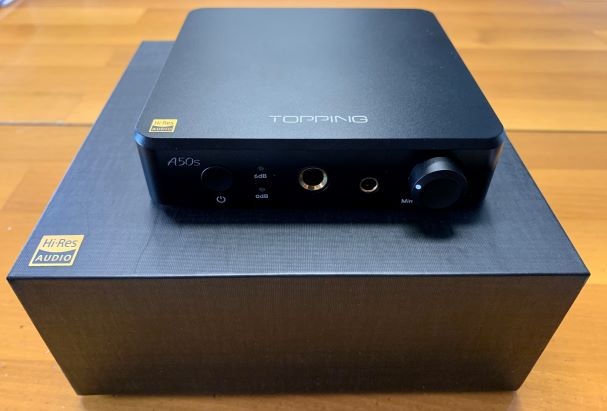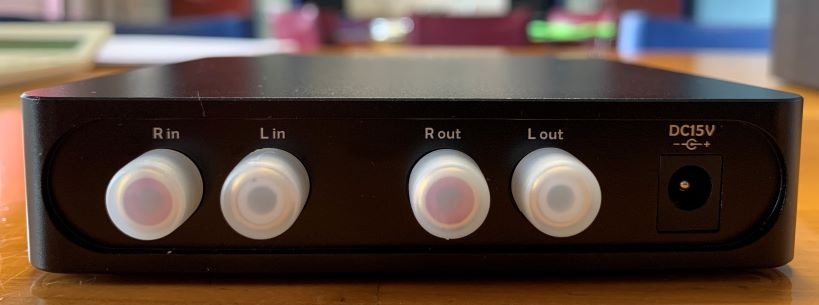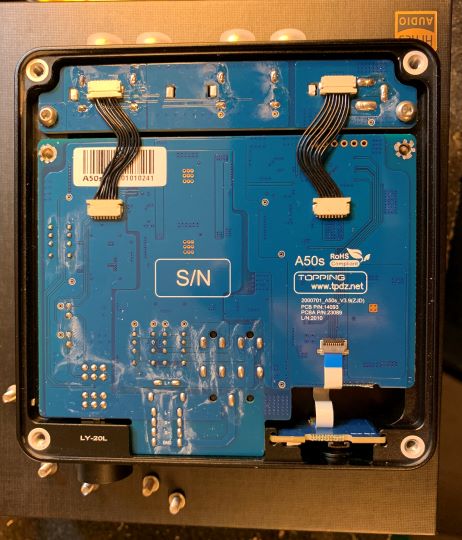Topping A50s
When "small" becomes "large"

[ Home | Staff & Contacts | HiFi Playground | Listening tests | DIY & Tweakings | Music & Books ]

Product: headphone amplifier & preamplifier
Manufacturer: Guangzhou Topping Electronics & Technology Co.
Recommended Retail Price: 209€
Distributed in Italy by AudioAzimuth
Reviewer: Piero Canova -
TNT Italy
Reviewed: May, 2021
It is now twenty years ago that I visited, for business reasons, the People's Republic of China (PRC). It all started in 2002 when the company I was working with made an acquisition that had a manufacturing site in the Guangdong region. Since then, I made a growing number of visits and contacts with several local companies. In the beginning, the majority of companies I dealt with were suppliers of components, but progressively they became suppliers of finished goods. Early on, many of these were deeply inspired by designs from European or North America, but step by step they started to develop their own original products. Guangzhou Topping is, for me, the perfect example of this approach, as they offer a quite comprehensive catalogue of amplifiers and DACs with an individual house design and some original circuitry. I was quite interested in understanding what was their current level of performance so I gladly accepted the proposal to test one of their hi-fi products.
The catalogue describes the Topping A50s as a "desktop headphone amplifier", but this is a reductive description. While in the front there are the headphone outputs, in the back, threre are also two RCA single-ended outputs that make the A50s a minimalist preamplifier (one input only, just gain control through the volume knob). Another interesting thing is that the design has no Bluetooth or USB input perhaps indicating a more audiophile use rather than just connecting it to a computer on your desk. It arrived in a nice black box looking very much like typical mobile phone packaging, just twice the size. The manual inside isn't so full of information and under it there is a small black box 123mm x 110mm x 46mm thick weighing approximately half a Kilo and a wall power supply 15V 1000mA, much lighter and smaller than that provided with many mobile phones. The device input is via a customer installed Schuko or UK plug.
The front panel is very simple: an on-off switch, two jack sockets (4,4 and 6,7mm), a volume knob, and two white leds indicating low gain (+0dB) or high gain (+6dB). Switching on the A50s one of the two leds will light indicating that the unit is operative. Pressing gently the on-off switch you can swap between low and high gain. Now, the question is, why have two headphone sockets? Because one the two (the 4,4mm) is balanced. Now, this is interesting: the A50s is a true balanced design and this explains the reason for a dedicated output, but there isn't a balanced input so the tangible benefit of ths construction is the added gain you have through a balanced connection. The rear panel is even simpler in layout, if that's possible, with two RCA connectors for input, two for output, and the socket for the power supply. As in many products manufactured in the PRC, there is outstanding care with details: all rear connections are protected with some small plastic caps. I cannot say for sure that such care will improve the performance, but this shows the will to send the products to the end-user in the best possible condition and this is quite valuable for me.

The quality of construction is excellent: it is made from an aluminum shell formed through a high-quality CNC process. Edges and corners are nicely rounded and the whole is finished with a high-quality black or silver anodization. The finish level is on par with one of today's leading industries which is one of mobile phones. Access to the inside is through the bottom plate which is fixed to the main body with four Allen screws so, viewing it as it is used, you don't see any joints or fasteners. Now, I accept the poin that this is far easier if the equipment is small but, as it was in the Faseaudio Phonodrive 2.0, it leads to another question: do we really need equipment of standard size today? Circuitry-wise it is built according to the latest trends: SMD assembly, OP-Amps in the gain stages using a technology named NFCA. I tried to see a bit more by opening the case, but as you can see, the components are on the upper side of the circuit board and to see any more it would need some serious disassembly. The only visible thing is the great efforts of the designer in making the product the simplest possible.

The measurements and graphs enclosed show excellent properties: SNR of
137dB (unbalanced) and 143 dB (balanced); dynamic range of 138 dB
(unbalanced) and 144 dB (balanced). Frequency response from 20Hz to 200KHz
+-0,05dB; crosstalk -86 dB unbalanced and -128dB balanced. On paper, these
are really top performances so we can move to the next question.
Since the A50s is offered as a headphone amplifier the first part of this test has been made using it in this way. I connected the phono stage Faseaudio Phonodrive 2.0 to the input of the A50s and my trusted Pioneer headphones to the output jack. The source was a Denon DP6000 turntable on a custom-made plinth weighing 80 Kg, one of my 15" arms and as cartridge, a Shelter 901. The gain was more than enough with the "0dB" setting; I had just to use the adapter included in the box to go from the 2,5mm mini-jack that I have installed after rewiring my headphones to the 4,4mm. I was immediately happy with the quality of the sound, but, to be sure that the headphone wasn't the limiting factor I borrowed a friend of mine's AKG K872 to find the limit of performance. Everything was again OK but, while with the Pioneer, which is a little dark tonally was fine, with the AKGs the low end was tending to be too light leaving me to doubt that it was the A50s that is slightly thin on low frequencies or if it was a characteristic of the AKG.
It was necessary to find some absolute reference so, one rainy Sunday afternoon I decided to use it in pre-amplifier mode. I disconnected my Jeff Rowland Sinergy and replaced it with the A50s that was then directly feeding my NuForce Ref9 SE power amps. I have had the Sinergy for almost 15 years and I know its sound quite well so any changes in the overall sound had to be coming from the A50s. I had just to replace a pair of my cables from balanced to single-ended and to change the switch in the rear of the NuForce from balanced to unbalanced and we were ready.
Gain is more than enough in the 0dB mode. The Sinergy performs at its best with built-in gain controls toward the maximum, but the A50S had a bit more; no need to go for the +6dB. Floor noise is lower in the Jeff Rowland, but not so much: without a reference to compare it to, I could happily live with the A50s. Volume control is solid and very silent; even at 50%, your reach high sound pressure levels so the second half of the range is quite useless unless you have some very low sensitivity power amps or speakers.
The depth of the sound stage is almost identical while on width there is a substantial reduction. With the A50s the width is concentrated between the speakers while with the Sinergy it goes well beyond them using all the width of the room and even part of the side walls. The mid-range is the strong point of the A50s and again gets quite close to the Sinergy. Voices are precise and stable, the text of the songs is clearly understandable and the position of the instruments on the stage is precise and they are well separated. High frequencies are slightly excessive and a bit harsh, but brilliant and realistic. The low frequencies are solid and fast, but it loses quite a lot of punch, especially in the two-three lower octaves. I believe the problem in this range is the power supply, but Topping offers a beefier power supply (P50, 129€ RRP) that in my view could cure at least part of this thinness.
Having some friends who are very familiar with my setup,listening to the A50s, the differences in stage width and low end were immediately caught while the others were surprised, caught out just after I told them they weren't listening to the Sinergy. Now, the Jeff Rowland Sinergy had a list price of 6.950€ that in today's currency would be close to 10.000€, while the A50s retails at 209€ so one forty-sixth of the Jeff Rowland. Furthermore, I have chosen the Sinergy and not the 2 or 2i because, in my view, it is the best performer of the three in the low frequencies. Finally, the Sinergy benefits from all the improvements I have found (G Flex feet, Siltech power cable, and similar) while the A50s was performing "as is". I did try some soft feet, but it is too light also for the small Isonodes; I will need to work a bit further on this. Some copper interconnects instead of my actual ones in silver to smoothen the highs might also be welcome. You should be careful of using some high-end cables: the space between the connectors allows the use of big connectors, but if the cable is too heavy the combination will be unstable. Electrical consumption is negligible, there is no need for a warm up period, but if you prefer you can leave it always on. It doesn't get warm, never made any noise and it is also very resistant to external disturbances.
After my test of the A50s as a preamplifier, I returned to the headphone amplifier mode, and to take the opportunity of reviewing it against some other equipment. I added to the panel of headphones used and I have used my Sony WH-1000X M3 using the wire connection available removing the wireless connection as a variable.
The performance I found using the A50s in the preamplifier mode has been confirmed. The second batch of headphone listening again gave me confidence in my earlier comments: it is very silent and the output is more than enough to drive all the headphones I have tested. The sound stage is less credible than in the preamplifier mode, but much better than that using the internal amplifier of the Sony headphones. The mid-range is the strong point of the A50s and especially vocals: every word can be understood, singing is top class as well as the visibility of all the effects applied to the voices. It is still a bit dry on low frequencies and a bit harsh on highs so using a headphone which has a "dark" character, like my Pioneer, brings balance to the sound and gives a good result.
If I could find a parallel in audio reproduction to the sound of the A50s, it presents a bit like a nearfield studio monitor: lows very fast and controlled, mediums very transparent, and highs a bit too shiny. In short, it is a very good piece of equipment with a price/performance ratio that's very attractive. It isn't a giant killer, but if the price was three times what it is nobody would complain and I doubt there is anything better in this price bracket.
The first message is for the owners of a Jeff Rowland preamplifier: relax. You have spent our money very well and that a Topping A50s isn't today an alternative to your Sinergy, Coherence, Concerto, or Corus.
To those that are planning to build a minimalistic system (one source only) with reasonable spending limits, I recommend listening to the A50s possibly together with its P50 power supply. I am convinced it could be an alternative to several more expensive components or even to some high-level vintage amplifiers.
Finally, if you plan to use it as a headphone amplifier you will have an excellent performer with enough power to drive any headphone with a preference for those a bit tonally dark. The test is, as a preamplifier, it shows that its quality is excellent so you will need to match it with some high-level headphones to exploit all its potential.
And finally: today it isn't a match for my Sinergy, but tomorrow? With this fast pace of evolution how long it will take Topping to be in the same league?
My warmest thanks to the Italian importer AudioAzimuth for the courtesy in giving us the sample tested.
DISCLAIMER. TNT-Audio is a 100% independent magazine that neither accepts advertising from companies nor requires readers to register or pay for subscriptions. After publication of reviews, the authors do not retain samples other than on long-term loan for further evaluation or comparison with later-received gear. Hence, all contents are written free of any “editorial” or “advertising” influence, and all reviews in this publication, positive or negative, reflect the independent opinions of their respective authors. TNT-Audio will publish all manufacturer responses, subject to the reviewer's right to reply in turn.
![[Find us on Facebook!]](../jpg/fb_small.jpg)
© Copyright 2021 Piero Canova - piero@tnt-audio.com - www.tnt-audio.com
[ Home | Staff & Contacts | HiFi Playground | Listening tests | DIY & Tweakings | Music & Books ]